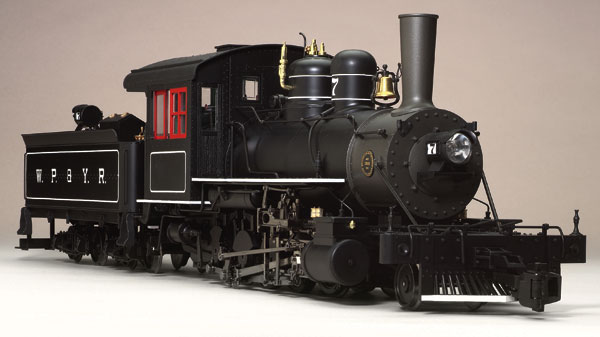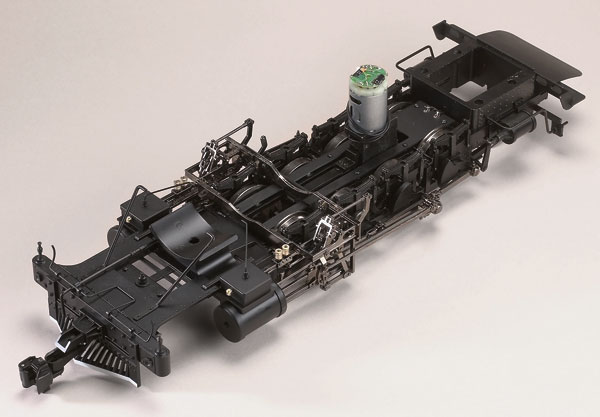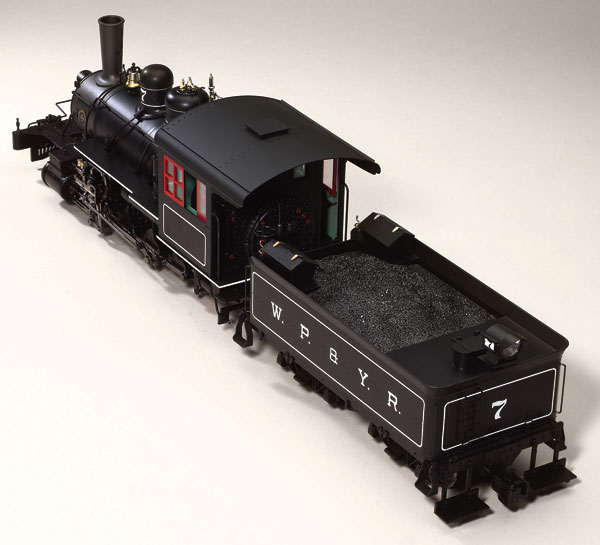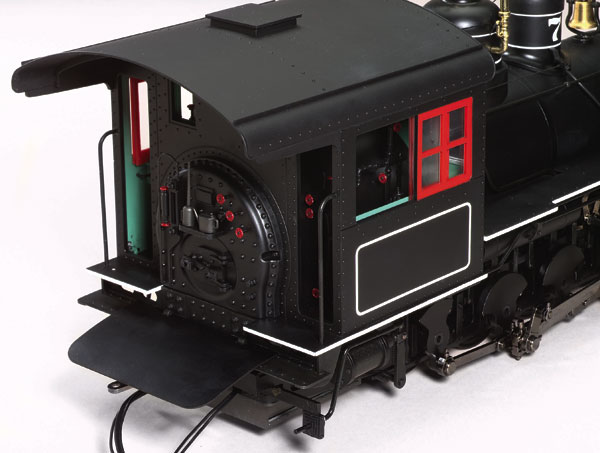This 1:20.3 model is built to the proposed National Model Railroad Association Fn3 standard of 15mm=12″ scale. It operates on No. 1 gauge (45mm) track. The 1:20.3 proportion is correct for accurately modeling three-foot narrow gauge using this track gauge.
As an outside-frame locomotive, this 2-8-0’s drivers are positioned between the frames with the crankpins, counterweights, and valve gear mounted on the outboard axle ends. This arrangement made the locomotive more stable and provided more width for the firebox.
According to Lee Riley of Bachmann, these Baldwin class E-2 Consolidations were built in large numbers during the early 20th century in nine different gauges. This model represents a typical three-foot-gauge locomotive.
I was unable to locate a prototype drawing, but the locomotive’s major scale dimensions are all within the range of similar locomotives listed in a 1915 Baldwin catalog reprint. The model locomotive and tender measure 31½” long, 7″ tall, and 5½” wide.
A well-illustrated 24-page 7½” x 4½” instruction booklet explains the locomotive’s history, features, lubrication, operation, and optional features. Four 81/2″ x 11″ pages of exploded isometric drawings and two pages of electrical diagrams document how the model is assembled and wired.
A close inspection of the Bachmann 2-8-0 revealed many interesting features. The main frame, siderods, and valve gear are cast in a hard zinc alloy, while the brake shoes, cylinders, and other detail parts are molded plastic. The formed wire piping is strong and looks great.
The boiler and cab are made up of plastic parts with numerous separately added details. It has a brass bell with a clapper, a brass whistle, wood grain detail, and chemically blackened cast metal details.
Like many narrow gauge locomotives, the model’s firebox extends through the deckless cab. The backhead has a movable firebox door, valves, a sight glass, and a shelf holding two oil cans. The cab windows slide and the front doors work. Up front, the smokebox door can be opened to reveal control switches for the smoke unit and to change the locomotive’s polarity.
Mechanically, the locomotive is fully sprung with soft springs, which allow the axles to move up and down as they pass over variations in the track. A heavy cast metal weight is concealed within the boiler and it’s positioned so the engine is properly balanced between its second and third sets of drivers for maximum tractive effort.
The tender is plastic with plastic archbar trucks and metal wheelsets. Electrical contacts pick up current from all of the wheels. Openings are provided in the floor for an optional speaker. Six flexible wires between the engine and tender connect the electrical circuits.
The Bachmann knuckle couplers are extremely low, but this height matches the firm’s other rolling stock and many other brands of Gn3 trains. This height is nearly an inch below the National Model Railroad Association’s standard height of 17/16″ (railhead to vertical center of the coupler) for large scale trains. Both the locomotive and tender have provisions for an easy change to a standard height coupler using a Kadee no. 791 magnetic knuckle coupler on the pilot and a no. 836 on the tender.
This 1:20.3 model is about an inch wider than most trains built to 1:22.5 proportion. This means the Consolidation requires more generous trackside clearances, especially on curves.
The middle drivers are blind (without flanges), but the model still requires the wider (32½” radius) sectional track curves due to clearances between the locomotive and tender. An optional plastic deck plate allows it to negotiate a somewhat tighter curve.
The Bachmann 2-8-0 started and ran smoothly and quietly. It performed well at the lows speeds common on most narrow gauge prototypes. At 20 volts, its drawbar pull is equivalent to 38 free-rolling cars on straight and level track.
Overall, Bachmann has created another excellent model locomotive that runs well and looks good. Its outside frame design provides a lot of interesting action as the counterweights, siderods, and valve gear rotate. Considering its pulling power, this Consolidation is bound to be popular among large scale modelers.
Price: $799.95
Manufacturer:
Bachmann Industries
1400 E. Erie Ave.
Philadelphia, PA 19124
215-533-1600
Description:
Ready-to-run plastic and metal steam locomotive
Features:
Cab interior
Can motor
DCC ready
Directional headlights
Drawbar pull: 38 ounces
Engine weight: 12 pounds
Knuckle couplers
LED lighting in firebox
Minimum radius: 32½”
Movable reverse lever in cab with working valve gear
Sliding cab windows
Smoke generator
Road names:
Deadwood Central
Silverton & Northern
White Pass & Yukon
Yellow Pine Lumber Co.
Painted-no lettering

















